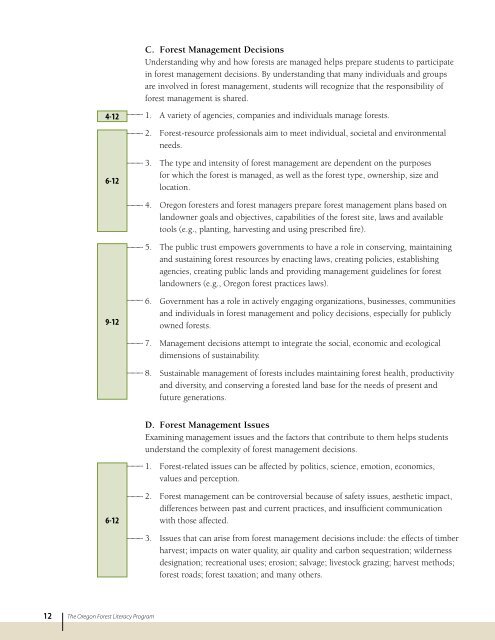Oregon Forest Literacy Program (PDF) - Learn Forests
Oregon Forest Literacy Program (PDF) - Learn Forests
Oregon Forest Literacy Program (PDF) - Learn Forests
Create successful ePaper yourself
Turn your PDF publications into a flip-book with our unique Google optimized e-Paper software.
4-12<br />
C. <strong>Forest</strong> Management Decisions<br />
Understanding why and how forests are managed helps prepare students to participate<br />
in forest management decisions. By understanding that many individuals and groups<br />
are involved in forest management, students will recognize that the responsibility of<br />
forest management is shared.<br />
1.<br />
2.<br />
A variety of agencies, companies and individuals manage forests.<br />
<strong>Forest</strong>-resource professionals aim to meet individual, societal and environmental<br />
needs.<br />
6-12<br />
9-12<br />
3.<br />
4.<br />
5.<br />
6.<br />
7.<br />
8.<br />
The type and intensity of forest management are dependent on the purposes<br />
for which the forest is managed, as well as the forest type, ownership, size and<br />
location.<br />
<strong>Oregon</strong> foresters and forest managers prepare forest management plans based on<br />
landowner goals and objectives, capabilities of the forest site, laws and available<br />
tools (e.g., planting, harvesting and using prescribed fire).<br />
The public trust empowers governments to have a role in conserving, maintaining<br />
and sustaining forest resources by enacting laws, creating policies, establishing<br />
agencies, creating public lands and providing management guidelines for forest<br />
landowners (e.g., <strong>Oregon</strong> forest practices laws).<br />
Government has a role in actively engaging organizations, businesses, communities<br />
and individuals in forest management and policy decisions, especially for publicly<br />
owned forests.<br />
Management decisions attempt to integrate the social, economic and ecological<br />
dimensions of sustainability.<br />
Sustainable management of forests includes maintaining forest health, productivity<br />
and diversity, and conserving a forested land base for the needs of present and<br />
future generations.<br />
D. <strong>Forest</strong> Management Issues<br />
Examining management issues and the factors that contribute to them helps students<br />
understand the complexity of forest management decisions.<br />
1.<br />
<strong>Forest</strong>-related issues can be affected by politics, science, emotion, economics,<br />
values and perception.<br />
6-12<br />
2.<br />
3.<br />
<strong>Forest</strong> management can be controversial because of safety issues, aesthetic impact,<br />
differences between past and current practices, and insufficient communication<br />
with those affected.<br />
Issues that can arise from forest management decisions include: the effects of timber<br />
harvest; impacts on water quality, air quality and carbon sequestration; wilderness<br />
designation; recreational uses; erosion; salvage; livestock grazing; harvest methods;<br />
forest roads; forest taxation; and many others.<br />
12 The <strong>Oregon</strong> <strong>Forest</strong> <strong>Literacy</strong> <strong>Program</strong>



